User:Jaspergeli/Aquarium
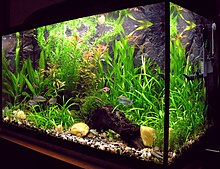
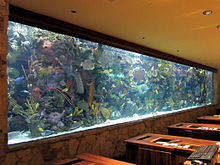
An aquarium (plural: aquariums or aquaria) is a vivarium of any size mostly having at least one transparent side in which aquatic animals or plants are kept and displayed. Hobbyists use aquariums/aquaria to keep fishes, aquatic invertebrates, aquatic amphibians, and aquatic plants. The term "aquarium", coined by English naturalist Philip Henry Gosse, combines the Latin root aqua, meaning water, with the suffix -arium, meaning "a place for relating to". Any tank or container with aquatic life being kept is called an aquarium. Of course, it has principles, the main thing is to keep its ecosystem balanced and the organisms inside are doing well. Temperature, pH level, fish size, fish quantity, diet, temperament, breeding and reproduction, salinity, etc. are the things to consider before getting an aquarium. The aquarium principle was fully developed in 1850 by the chemist Robert Warington, who explained that plants added to water in a container would give off enough oxygen to support animals, so long as the numbers of animals did not grow too large. The aquarium craze was launched in early Victorian England by Gosse, who created and stocked the first public aquarium at the London Zoo in 1853, and published the first manual, The Aquarium: An Unveiling of the Wonders of the Deep Sea in 1854. Small aquariums are kept in the home by hobbyists. A large aquarium may have otters, turtles, dolphins, and other sea animals. Most aquarium tanks also have plants.
An aquarist owns fish or maintains an aquarium, typically constructed of glass or high-strength acrylic. Cuboid aquaria are also known as fish tanks or simply tanks, while bowl-shaped aquaria are also known as fish bowls. Size can range from a small glass bowl, under a few liters in volume, to immense public aquaria of several thousand liters. Specialized equipment maintains appropriate water quality and other characteristics suitable for the aquarium's residents.
Design[edit]

Materials[edit]
Most aquaria consist of glass panes bonded together by 100% silicone sealant, with plastic frames attached to the upper and lower edges for decoration. The glass aquarium is standard for sizes up to about 1,000 litres (260 US gal; 220 imp gal). However, glass as a material is brittle and has very little give before fracturing, though generally, the sealant fails first. Aquaria are made in a variety of shapes, such as cuboid, hexagonal, angled to fit in a corner (L-shaped), and bow-front (the front side curves outwards). Fish bowls are generally either made of plastic or glass and are either spherical or some other round configuration in shape.
The very first modern aquarium made of glass was developed in the 19th century by Robert Warrington. During the Victorian age, glass aquariums commonly had slate or steel bottoms, which allowed them to be heated underneath by an open-flame heat source. These aquariums had the glass panels attached to metal frames and sealed with putty. Metal-framed aquariums were still available until the mid-1960s when the modern, silicone-sealed style replaced them. Acrylic aquariums first became available to the public in the 1970s. Laminated glass is sometimes used, which combines the advantages of both glass and acrylic.
Glass aquaria have been a popular choice for many home and hobbyist aquarists for many years. Once silicone sealant became strong enough to ensure a long-term water-tight seal, it eliminated the need for a structural frame. In addition to lower cost, glass aquaria are more scratch resistant than acrylic. Although the price is one of the main considerations for aquarists when deciding which of these two types of aquaria to purchase, for very large tanks, the price difference tends to disappear.
Acrylic aquaria are now the primary competitor with glass. Prior to the invention of UV stabilization, early acrylic aquaria discolored over time with exposure to light; this is no longer the case. Acrylic is generally stronger than glass, weighs less, and provides a certain amount of temperature insulation. In colder climates or environments, it is easier to achieve and maintain a tropical temperature and requires less capacity from an aquarium heater. Acrylic-soluble cement is used to directly fuse acrylic together. Acrylic allows for the formation of unusual shapes, such as the hexagonal tank. Compared to glass, acrylics are easier to scratch; but unlike glass, it is possible to polish out scratches in acrylic.
Large aquaria might instead use stronger materials such as fiberglass-reinforced plastics. However, this material is not transparent. Reinforced concrete is used for aquaria where weight and space are not factors. Concrete must be coated with a waterproof layer to prevent the water from breaking down the concrete, as well as preventing contamination of the water by the concrete.
Plywood can also be used when building aquaria. The benefits of using plywood include lower construction costs, less weight, and better insulation. A popular positioning choice for plywood aquaria is keeping them in a wall. Here the use of plywood is hidden by sinking the aquarium inside the wall. Putting insulation between the two helps with the insulation of a heated tank.
Styles[edit]

Objects used for aquariums include coffee tables, sinks, gumball machines and even toilets. Another such example is the MacQuarium, an aquarium made from the shell of an Apple Macintosh computer. In recent years, elaborate custom-designed home aquariums costing hundreds of thousands of dollars have become status symbols—according to The New York Times, "among people of means, a dazzling aquarium is one of the last surefire ways to impress their peers."
Kreisel[edit]
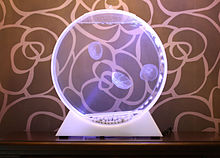
A kreisel tank ("kreisel" being German for "spinning top" or "gyroscope") is an aquarium shaped like a horizontal cylinder that is designed to hold delicate animals such as jellyfish and newborn seahorses. These aquariums provide slow, circular water flows with a bare minimum of interior hardware to prevent the inhabitants from becoming injured by pumps or the tank itself. The tank has no sharp angles around its sides and keeps the housed animals away from plumbing. Water moving into the tank gives a gentle flow that keeps the inhabitants suspended. Water leaves the tank through a screen which prevents animals from being drawn into the pump intake or overflow line.
There are several types of kreisel tanks. In a true kreisel, a circular tank has a circular, submerged lid. Pseudokreisels are "U" or semicircle shaped, usually without a lid. Stretch kreisels are a "double gyre" kreisel design, where the tank length is at least twice the height. Using two downwelling inlets on both sides of the tank lets gravity create two gyres in the tank. A single downwelling inlet may be used in the middle as well. The top of a stretch kreisel may be open or closed with a lid. There may also be screens about midway down the sides of the tank, or at the top on the sides. It is possible to combine these designs; a circularly shaped tank is used without a lid or cover, and the surface of the water acts as the continuation of circular flow.
Biotope[edit]
Another popular setup is the biotope aquarium. A biotope aquarium is a recreation of a specific natural environment. Some of the most popular biotopes are the freshwater habitats of the Amazon and Rio Negro rivers, the African rift lake environments of Lake Malawi and Lake Tanganyika, and saltwater coral reefs of Australia, the Red Sea, and the Caribbean. The fish, plants, substrate, rocks, wood, coral, and any other component of the display should completely match that of the local natural environment. It can be a challenge to recreate such environments, and most "true" biotopes will only have a few (if not only one) species of fish and invertebrates.
Finally, an emerging concept for the home is that of a wall mounted aquarium, some of which are displayed at the Living Art Marine Center.
Aquarium size and volume[edit]
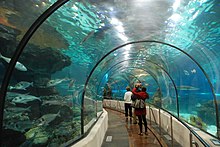
An aquarium can range from a small glass bowl containing less than 1 litre (2.1 US pt) of water to immense public aquaria that house entire ecosystems such as kelp forests. Relatively large home aquaria resist rapid fluctuations of temperature and pH, allowing for greater system stability. Beginner aquarists are advised to consider larger tanks, to begin with, as controlling water parameters in smaller tanks can prove difficult.
Unfiltered bowl-shaped aquaria are now widely regarded as unsuitable for most fish. Advanced alternatives are now available. In order to keep water conditions at suitable levels, aquariums should contain at least two forms of filtration: biological and mechanical. Chemical filtration should also be considered under some circumstances for optimum water quality. Chemical filtration is frequently achieved via activated carbon, to filter medications, tannins, and/or other known impurities from the water.
Reef aquaria under 100 litres (26 US gal; 22 imp gal) have a special place in the aquarium hobby; these aquaria, termed nano reefs (when used in reefkeeping), have a small water volume, under 40 litres (11 US gal; 9 imp gal).
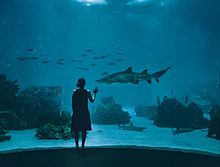
Practical limitations, most notably the weight of water (1 kilogram per litre (8.345 lb/U.S. gal; 10.022 lb/imp gal)) and internal water pressure (requiring thick glass siding) of a large aquarium, restrict most home aquaria to a maximum of around 1 cubic meter in volume (1000 L, weighing 1,000 kg or 2,200 lb). Some aquarists, however, have constructed aquaria of many thousands of liters.
Public aquariums designed for the exhibition of large species or environments can be dramatically larger than any home aquarium. The Georgia Aquarium, for example, features an individual aquarium of 6,300,000 US gallons (24,000 m3).
Nano aquariums[edit]
A new trend is to have very small aquariums, termed mini aquariums (less than 160 liters) or nano aquariums (less than 80 liters). These can be either freshwater or saltwater and are intended to display a tiny but self-contained ecosystem.
Components[edit]
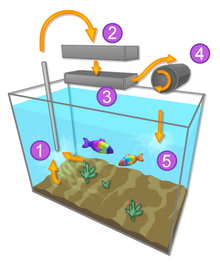
The typical hobbyist aquarium includes a filtration system, an artificial lighting system, and a heater or chiller depending on the aquarium's inhabitants. Many aquaria incorporate a hood, containing the lights, to decrease evaporation and prevent fish from leaving the aquarium (and anything else from entering the aquarium).
Combined biological and mechanical aquarium filtration systems are common. These either convert ammonia to nitrate (removing nitrogen at the expense of aquatic plants) or to sometimes remove phosphate. Filter media can house microbes that mediate nitrification. Filtration systems are sometimes the most complex component of home aquaria.
Aquarium heaters combine a heating element with a thermostat, allowing the aquarist to regulate water temperature at a level above that of the surrounding air, whereas coolers and chillers (refrigeration devices) are for use anywhere, such as cold water aquaria, where the ambient room temperature is above the desired tank temperature. Thermometers used include glass alcohol thermometers, adhesive external plastic strip thermometers, and battery-powered LCD thermometers. In addition, some aquarists use air pumps attached to airstones or water pumps to increase water circulation and supply adequate gas exchange at the water surface. Wave-making devices have also been constructed to provide wave action.
An aquarium's physical characteristics form another aspect of aquarium design. Size, lighting conditions, density of floating and rooted plants, placement of bog-wood, creation of caves or overhangs, type of substrate, and other factors (including an aquarium's positioning within a room) can all affect the behavior and survival of tank inhabitants.
An aquarium can be placed on an aquarium stand. Because of the weight of the aquarium, a stand must be strong as well as level. A tank that is not level may distort, leak, or crack. These are often built with cabinets to allow storage, available in many styles to match room decor. Simple metal tank stands are also available. Most aquaria should be placed on polystyrene to cushion any irregularities on the underlying surface or the bottom of the tank itself that may cause cracks. However, some tanks have an underframe making this unnecessary.
Aquarium classifications[edit]
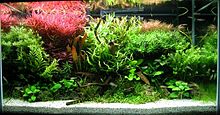
From the outdoor ponds and glass jars of antiquity, modern aquaria have evolved into a wide range of specialized systems. Individual aquaria can vary in size from a small bowl large enough for only a single small fish, to the huge public aquaria that can simulate entire marine ecosystems.
One way to classify aquaria is by salinity. Freshwater aquaria are the most popular due to their lower cost. More expensive and complex equipment is required to set up and maintain marine aquaria. Marine aquaria frequently feature a diverse range of invertebrates in addition to species of fish. Brackish water aquaria combine elements of both marine and freshwater fishkeeping. Fish kept in brackish water aquaria generally come from habitats with varying salinity, such as mangrove swamps and estuaries. Subtypes exist within these types, such as the reef aquarium, a typically smaller marine aquarium that houses coral.
Another classification is by temperature range. Many aquarists choose a tropical aquarium because tropical fish tend to be more colorful. However, the coldwater aquarium is also popular, which is mainly restricted to goldfish, but can include fish from temperate areas worldwide and native fish keeping.
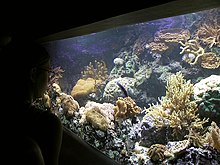
Aquaria may be grouped by their species selection. The community tank is the most common today, where several non-aggressive species live peacefully. In these aquaria, the fish, invertebrates, and plants probably do not originate from the same geographic region but tolerate similar water conditions. Aggressive tanks, in contrast, house a limited number of species that can be aggressive toward other fishes or are able to withstand aggression well. Most marine tanks and tanks housing cichlids have to take the aggressiveness of the desired species into account when stocking. Specimen tanks usually only house one fish species, along with plants, perhaps ones found in the fishes' natural environment and decorations simulating a natural ecosystem. This type is useful for fish that cannot coexist with other fish, such as the electric eel, as an extreme example. Some tanks of this sort are used simply to house adults for breeding.
Ecotype, ecotope, or biotope aquaria is another type based on species selection. In it, an aquarist attempts to simulate a specific natural ecosystem, assembling fish, invertebrate species, plants, decorations and water conditions all found in that ecosystem. These biotope aquaria are the most sophisticated hobby aquaria; public aquaria use this approach whenever possible. This approach best simulates the experience of observing in the wild. It typically serves as the healthiest possible artificial environment for the tank's occupants.
Public aquaria[edit]

Most public aquarium facilities feature a number of smaller aquaria, as well those too large for home aquarists. The largest tanks hold millions of liters of water and can house large species, including sharks or beluga whales. Dolphinaria are specifically for dolphins. Aquatic and semiaquatic animals, including otters and penguins, may also be kept by public aquaria. Public aquaria may also be included in larger establishments such as a marine mammal park or a marine park.
Making an aquarium[edit]
It is great to have an aquarium but you'll need equipment to be successful in the aquarium hobby. In the aquarium, you will need a filter, air pump, water pump, heater, etc. However, this page will help you in how to make a simple natural aquarium and run it without electricity. Creating an aquarium is the best part because you enjoy putting sand, gravel, pebbles, plants, water, and of course, the fish and other creatures in your aquarium. All water types can sustain their selves if there are photosynthetic organisms underwater.
Aquarium filter[edit]
Aquarium filter is an equipment which is used to clean aquarium tanks. This also makes a surface agitation in water which gas exchange occurs rapidly. Aquarium filter is important, in fact, but the aquarium can work out without it, but still, cleaning the aquarium makes it easier if you have a filter. Aquarium filters are critical components of both freshwater and marine aquaria. Aquarium filters remove physical and soluble chemical waste products from aquaria, simplifying maintenance. Furthermore, aquarium filters are necessary to support life as aquaria are relatively small, closed volumes of water compared to the natural environment of most fish.
Moving bed filter[edit]
In my opinion, the moving bed filter (K1 (filter media)) is the best filter, because it prevents clogging which makes the media distributed properly and getting the same amount of oxygen, the bubbles contact with water which means more gas exchange, thus, better filtration.
Water movement[edit]
Water movement is pleasing to the eyes as it mimics the flow of the running water in the wild. It is essential as it provides aeration which creates very much surface area in contact with air. Water movement is either from the air pumps or water pumps/waterfalls.
Water movement is always a good thing, even if it's not required. Add air stones for more surface area if you have an air pump as an optional need. If you have dead spots, you run the risk of increasing algae in that area.
Ideal tank/container dimensions[edit]
Take note that you have 1-cm glass width and should need 128% height allowance. Though the values can be applied in any dimension (length, height, and width), the following examples are ideal.
- 20-liter tank
- 32 × 25 × 25 cm (34 × 33 × 27 cm)
- 25-liter tank
- 40 × 25 × 25 cm (42 × 33 × 27 cm)
- 40-liter tank
- 50 × 25 × 32 (52 × 33 × 34 cm)
- 50-liter tank
- 80 × 25 × 25 cm (82 × 33 × 27 cm)
- 64-liter cube tank
- 40 × 40 × 40 cm (42 × 33 × 42 cm)
- 80-liter tank
- 80 × 25 × 40 cm (82 × 33 × 42 cm)
- 50 × 40 × 40 cm (42 × 33 × 27 cm)
Aquarium salinity[edit]
Freshwater aquarium[edit]
My own definition of freshwater has approximately 0.5 salt ppt. Some brackish and saltwater or marine fishes and plants can tolerate freshwater. Freshwater has 125% more oxygen than saltwater or marine.
Brackish aquarium[edit]
My own definition of brackish water has approximately 17.75 salt ppt. Brackish water is the hardest salinity of water to keep by keeping species alive; it's very few naturally occurring species and certain hardy freshwater and saltwater or marine species can tolerate this type of water, and if not acclimated properly, many species will be stressed and may die soon. Brackish water's salinity is too high compared with freshwater and too low compared with saltwater or marine. Very few natural plants and fishes and other animals live in brackish water, so you need hardy freshwater and saltwater or marine plants and fishes and other animals can tolerate brackish water.
Saltwater or marine aquarium[edit]
My own definition of saltwater or marine has approximately 35 salt ppt. Some freshwater or brackish fishes and plants can tolerate saltwater or marine. Saltwater or marine has 20% less oxygen than freshwater.
Aquarium maintenance[edit]

Large volumes of water enable more stability in a tank by diluting effects from death or contamination events that push an aquarium away from equilibrium. The bigger the tank, the easier such a systemic shock is to absorb, because the effects of that event are diluted. For example, the death of the only fish in a 10-litre (3 US gal; 2 imp gal) tank causes dramatic changes in the system, while the death of that same fish in a 400-litre (110 US gal; 88 imp gal) tank with much other fish in it represents only a minor change. For this reason, hobbyists often favor larger tanks, as they require less attention.
Several nutrient cycles are important in the aquarium. Dissolved oxygen enters the system at the surface water-air interface. Similarly, carbon dioxide escapes the system into the air. The phosphate cycle is important, although often overlooked, nutrient cycle. Sulfur, iron, and micronutrients also cycle through the system, entering as food and exiting as waste. Appropriate handling of the nitrogen cycle, along with supplying an adequately balanced food supply and considered biological loading, is enough to keep these other nutrient cycles in approximate equilibrium.
An aquarium must be maintained regularly to ensure that the fish are kept healthy. Daily maintenance consists of checking the fish for signs of stress and disease. Also, aquarists must make sure that the water has a good quality and it is not cloudy or foamy and the temperature of the water is appropriate for the particular species of fish that live in the aquarium.
Typical weekly maintenance includes changing around 20% of the water while cleaning the gravel, or other substrates if the aquarium has one; however some manage to avoid this entirely by keeping it somewhat self-sufficient. A good habit is to remove the water being replaced by "vacuuming" the gravel with suitable implements, as this will eliminate uneaten foods and other residues that settle on the substrate. In many areas tap water is not considered to be safe for fish to live in because it contains chemicals that harm the fish. Tap water from those areas must be treated with a suitable water conditioner, such as a product which removes chlorine and chloramine and neutralizes any heavy metals present. The water conditions must be checked both in the tank and in the replacement water, to make sure they are suitable for the species.
Water conditions[edit]
The solute content of water is perhaps the most important aspect of water conditions, as total dissolved solids and other constituents dramatically impact basic water chemistry, and therefore how organisms interact with their environment. Salt content, or salinity, is the most basic measure of water conditions. An aquarium may have freshwater (salinity below 500 parts per million), simulating a lake or river environment; brackish water (a salt level of 500 to 30,000 PPM), simulating environments lying between fresh and salt, such as estuaries; and salt water or seawater (a salt level of 30,000 to 40,000 PPM), simulating an ocean environment. Rarely, higher salt concentrations are maintained in specialized tanks for raising brine organisms.
Saltwater is typically alkaline, while the pH (alkalinity or acidicity) of fresh water varies more. Hardness measures overall dissolved mineral content; hard or soft water may be preferred. Hard water is usually alkaline, while soft water is usually neutral to acidic. Dissolved organic content and dissolved gases content are also important factors.
Home aquarists typically use tap water supplied by their local water supply network to fill their tanks. Straight tap water cannot be used in localities that pipe chlorinated water. In the past, it was possible to "condition" the water by simply letting the water stand for a day or two, which allows the chlorine time to dissipate. However, chloramine is now used more often and does not leave the water as readily. Additives formulated to remove chlorine or chloramine are often all that is needed to make the water ready for aquarium use. Brackish or saltwater aquaria require the addition of a commercially available mixture of salts and other minerals.
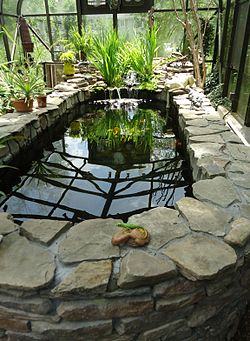
Some aquarists modify water's alkalinity, hardness, or dissolved content of organics and gases, before adding it to their aquaria. This can be accomplished by additives, such as sodium bicarbonate, to raise pH. Some aquarists filter or purify their water through deionization or reverse osmosis prior to using it. In contrast, public aquaria with large water needs often locate themselves near a natural water source (such as a river, lake, or ocean) to reduce the level of treatment. Some hobbyists use an algae scrubber to filter the water naturally.
Water temperature determines the two most basic aquarium classifications: tropical versus cold water. Most fish and plant species tolerate only a limited temperature range; tropical aquaria, with an average temperature of about 25 °C (77 °F), are much more common. Cold water aquaria are for fish that are better suited to a cooler environment. More important than the range is consistency; most organisms are not accustomed to sudden changes in temperatures, which can cause shock and lead to disease. Water temperature can be regulated with a thermostat and heater (or cooler).
Water movement can also be important in simulating a natural ecosystem. Aquarists may prefer anything from still water up to swift currents, depending on the aquarium's inhabitants. Water movement can be controlled via aeration from air pumps, powerheads, and careful design of internal water flow (such as the location of filtration system points of inflow and outflow).
Nitrogen cycle[edit]
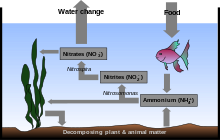
Of primary concern to the aquarist is the management of the waste produced by an aquarium's inhabitants. Fish, invertebrates, fungi, and some bacteria excrete nitrogen waste in the form of ammonia (which converts to ammonium, in water) and must then either pass through the nitrogen cycle or be removed by passing through zeolite. Ammonia is also produced through the decomposition of plant and animal matter, including fecal matter and other detritus. Nitrogen waste products become toxic to fish and other aquarium inhabitants at high concentrations. In the wild, the vast amount of water surrounding the fish dilutes ammonia and other waste materials. When fish are put into an aquarium, waste can quickly reach toxic concentrations in the enclosed environment unless the tank is cycled to remove waste.
The process[edit]
A well-balanced tank contains organisms that are able to metabolize the waste products of other aquarium residents. This process is known in the aquarium hobby as the nitrogen cycle. Bacteria known as nitrifiers (genus Nitrosomonas) metabolize nitrogen waste. Nitrifying bacteria capture ammonia from the water and metabolize it to produce nitrite. Nitrite is toxic to fish in high concentrations. Another type of bacteria (genus Nitrospira) converts nitrite into nitrate, a less toxic substance. (Nitrobacter bacteria were previously believed to fill this role. While biologically they could theoretically fill the same niche as Nitrospira, it has recently been found that Nitrobacter are not present in detectable levels in established aquaria, while Nitrospira are plentiful.) However, commercial products sold as kits to "jump start" the nitrogen cycle often still contain Nitrobacter.
In addition to bacteria, aquatic plants also eliminate nitrogen waste by metabolizing ammonia and nitrate. When plants metabolize nitrogen compounds, they remove nitrogen from the water by using it to build biomass that decays more slowly than ammonia-driven plankton already dissolved in the water.
Maintaining the nitrogen cycle[edit]

What hobbyists call the nitrogen cycle is only a portion of the complete cycle: nitrogen must be added to the system (usually through food provided to the tank inhabitants), and nitrates accumulate in the water at the end of the process or become bound in the biomass of plants. The aquarium keeper must remove water once nitrate concentrations grow, or remove plants which have grown from the nitrates.
Hobbyist aquaria often do not have sufficient bacteria populations to adequately denitrify waste. This problem is most often addressed through two filtration solutions: Activated carbon filters absorb nitrogen compounds and other toxins, while biological filters provide a medium designed to enhance bacterial colonization. Activated carbon and other substances, such as ammonia absorbing resins, stop working when their pores fill, so these components have to be replaced regularly.
New aquaria often have problems associated with the nitrogen cycle due to insufficient beneficial bacteria. Therefore, fresh water has to be matured before stocking them with fish. There are three basic approaches to this: the "fishless cycle", the "silent cycle" and "slow growth".
In a fishless cycle, small amounts of ammonia are added to an unpopulated tank to feed the bacteria. During this process, ammonia, nitrite, and nitrate levels are tested to monitor progress. The "silent" cycle is basically nothing more than densely stocking the aquarium with fast-growing aquatic plants and relying on them to consume the nitrogen, allowing the necessary bacterial populations time to develop. According to anecdotal reports, the plants can consume nitrogenous waste so efficiently that ammonia and nitrite level spikes seen in more traditional cycling methods are greatly reduced or disappear. "Slow growth" entails slowly increasing the population of fish over a period of 6 to 8 weeks, giving bacteria colonies time to grow and stabilize with the increase in fish waste. This method is usually done with a small starter population of hardier fish which can survive the ammonia and nitrite spikes, whether they are intended to be permanent residents or to be traded out later for the desired occupants.
The largest bacterial populations are found in the filter, where high water flow and plentiful surface available for their growth, so effective and efficient filtration is vital. Sometimes, a vigorous cleaning of the filter is enough to seriously disturb the biological balance of an aquarium. Therefore, it is recommended to rinse mechanical filters in an outside bucket of aquarium water to dislodge organic materials that contribute to nitrate problems, while preserving bacteria populations. Another safe practice consists of cleaning only half of the filter media during each service or using two filters, only one of which is cleaned at a time.
Biological load[edit]

The biological load, or bioload, is a measure of the burden placed on the aquarium ecosystem by its inhabitants. High biological loading presents a more complicated tank ecology, which in turn means that equilibrium is easier to upset. Several fundamental constraints on biological loading depend on aquarium size. The water's surface area limits oxygen intake. The bacteria population depends on the physical space they have available to colonize. Physically, only a limited size and number of plants and animals can fit into an aquarium while still providing room for movement. Biologically, biological loading refers to the rate of biological decay in proportion to tank volume. Adding plants to an aquarium will sometimes help greatly with taking up fish waste as plant nutrients. Although an aquarium can be overloaded with fish, an excess of plants is unlikely to cause harm. Decaying plant material, such as decaying plant leaves, can add these nutrients back into the aquarium if not promptly removed. The bioload is processed by the aquarium's biofilter filtration system.
Calculating capacity[edit]
Limiting factors include the oxygen availability and filtration processing. Aquarists have rules of thumb to estimate the number of fish that can be kept in an aquarium. The examples below are for small freshwater fish; larger freshwater fishes and most marine fishes need much more generous allowances.
- 4 cm of adult fish length per 5 liters of water.
- 1 cm of adult fish length per 25 square centimeters of surface area.
Experienced aquarists warn against applying these rules too strictly because they do not consider other important issues such as growth rate, activity level, social behavior, filtration capacity, the total biomass of plant life, and so on. It is better to apply the overall mass and size of a fish per liter of water than simply the length. This is because fish of different sizes produce quite different amounts of waste. Establishing maximum capacity is often a matter of slowly adding fish and monitoring water quality over time, following a trial and error approach.
Other factors affecting capacity[edit]
One variable is differences between fish. Smaller fish consume more oxygen per gram of body weight than larger fish. Labyrinth fishes can breathe atmospheric oxygen and do not need as much surface area (however, some of these fish are territorial, and do not appreciate crowding). Barbs also require more surface area than tetras of comparable size.
Oxygen exchange at the surface is an important constraint, and thus the surface area of the aquarium matters. Some aquarists claim that a deeper aquarium holds no more fish than a shallower aquarium with the same surface area. The capacity can be improved by surface movement and water circulation such as through aeration, which not only improves oxygen exchange but also waste decomposition rates.
Waste density is another variable. Decomposition in solution consumes oxygen. Oxygen dissolves less readily in warmer water; this is a double-edged sword since warmer temperatures make fish more active, so they consume more oxygen.
In addition to bioload/chemical considerations, aquarists also consider the mutual compatibility of the fish. For instance, predatory fish are usually not kept with small, passive species, and territorial fish are often unsuitable tankmates for shoaling species. Furthermore, fish tend to fare better if given tanks conducive to their size. That is, large fish need large tanks and small fish can do well in smaller tanks. Lastly, the tank can become overcrowded without being overstocked. In other words, the aquarium can be suitable with regard to filtration capacity, oxygen load, and water, yet still be so crowded that the inhabitants are uncomfortable.
For planted freshwater aquariums, it is also important to maintain a balance between the duration and quality of light, the number of plants, CO2, and nutrients. For a given amount of light, if there is an insufficient number of plants or insufficient CO2 to support the growth of those plants, so as to consume all the nutrients in the tank, the result would be algae growth. While there are fishes and invertebrates that could be introduced into the tank to clean up these algae, the ideal solution would be to find the optimal balance between the above-mentioned factors. Supplemental CO2 can be provided, whose quantity has to be carefully regulated, as too much CO2 may harm the fishes.
Tips[edit]
- Add salt. Any water body has salt, freshwater has low salinity, brackish has medium, and saltwater/marine has high salinity.
- Do not plant the plants in the anoxic zone, hydrogen sulfide can destroy their roots, that is also the reason why your substrate is deep.
- Do not overfeed.
- Do not overstock.
- Remember that the ratio of the species in the Poecilinae is 1 male to every 4 females, but commonly, this is only for breeding them, so you can still make the ratio 1:1 if they do fine.
- Schooling or shoaling fishes in small aquariums can school or shoal in a minimum of 4 but they do best in a group of 8 individuals.
- Culture or farm algae by putting it in a different tank with a/ big smooth rock/s and placing it/them in direct sunlight so you won't worry for the fishes or creatures that primarily eat algae or algae as their staple food or need a constant supply of algae.
- Not all organisms will do good in your one preferred setup, for example, two different plants live also in two different types of soil. Pick the organisms that both need the same requirements.
- Some fishes do not school when they feel comfortable.
How the ecosystem and cycles work[edit]

1 : Obligate aerobes need oxygen because they cannot ferment or respire anaerobically. They gather at the top of the tube where the oxygen concentration is highest.
2: Obligate anaerobes are poisoned by oxygen, so they gather at the bottom of the tube where the oxygen concentration is lowest.
3: Facultative anaerobes can grow with or without oxygen because they can metabolize energy aerobically or anaerobically. They gather mostly at the top because aerobic respiration generates more ATP than either fermentation or anaerobic respiration.
4: Microaerophiles need oxygen because they cannot ferment or respire anaerobically. However, they are poisoned by high concentrations of oxygen. They gather in the upper part of the test tube but not the very top.
5: Aerotolerant organisms do not require oxygen as they metabolize energy anaerobically. Unlike obligate anaerobes, however, they are not poisoned by oxygen. They can be found evenly spread throughout the test tube.
Cycling is good because it grows nitrogen-fixing and nitrifying bacteria in order to clean your aquarium by breaking down the "mulm" (the sludge that collects at the bottom of the aquarium), consisting of fish (and other animals') waste, decaying plant matter, and other assorted detritus, other organic material, matter or debris like cut parts, and leftover or uneaten food. For example, you feed your fish, then your fish poops. The poop and the uneaten food will decompose and produce ammonia (NH3) (it is processed by the nitrogen-fixing bacteria). The ammonia (NH3) is converted into nitrite (NO2) by nitrifying bacteria called Nitrosomonas and Nitrosococcus. The nitrite (NO2) is converted into nitrate (NO3) by nitrifying bacteria called Nitrobacter and Nitrospira. The nitrates are absorbed by the plants to restart the process, though they can also absorb ammonia and nitrites.
Plants produce oxygen when they photosynthesize (only in daytime or with sunlight or components of it), they take carbon dioxide (CO2) and water (H2O) and combine them using light energy to produce sugars and oxygen. This stores the energy in chemical bonds in the sugars and releases oxygen (O2). The plants use those sugars (like we do when we consume foods) for energy to photosynthesize again. Plants make sugars by oxidizing them with oxygen (O2), just like us to release the energy stored in the bonds. They exhale carbon dioxide (CO2) just like us when we breathe, but when plants are photosynthesizing, they release more oxygen (O2) during photosynthesis than they consume in respiration. They release the oxygen through the same pores that allow the carbon dioxide (CO2) to enter their leaf cells.
Anoxic zone is a zone where oxygen (O2) is completely depleted (as for zones with oxygen (O2), that is called oxic zone), and where anaerobic bacteria live, this can be achieved by having a deep substrate in your tank, particularly around 10 cm. These anaerobic microorganisms have different breathing types as there is no oxygen (O2) present at the zone where these microorganisms settle,
sulfate-reducing microorganisms can inhale sulfate (SO2−
4) which comes naturally from the decomposing matter and exhale hydrogen sulfide which poisonous to the fishes (H2S) and denitrifying bacteria can inhale nitrate (NO3) and exhale nitrogen (N2) which is commonly found in the water and air. Hydrogen sulfide (H2S) is a harmful chemical that results from the microbial breakdown of the organic matter in the absence of oxygen and has a significant smell of rotten eggs. Hydrogen sulfide (H2S) isn't harmful to your fish as long as the water in oxic zone is well-oxygenated, because as it goes up the substrate and comes contact with the oxygen (O2), it turns into non-harmful sulfate (SO2−
4) which the sulfate-reducing microorganisms inhale and commonly produced in decomposing material.
It is possible to create an actual self-sustaining aquarium where actual food chains and webs occur, as long as the supply or sources of each organism are enough for them to sustain their life for very long time and adapt the environment before the supplies or sources vanish. The biodiversity should be high in order for the organisms to adapt without having a problem of extinction, this is to transition the energy little by little not drastically. Though it's hard to make an actual ecosystem like a food chain going on in your tank and you need to not let one of your kept organisms vanish inside your tank and if you can't do a food chain, you are the one who should control the organism's population. Also, you can create an aquarium that prevents inbreeding depression in the species, there is a minimum viable population or minimum effective number of individuals of one species of any organism that prevents them from inbreeding depression. It is the smallest possible size at which a biological population can exist without facing extinction from natural disasters or demographic, environmental, or genetic stochasticity. Like in humans, basically, you need 50 breeding individuals to avoid inbreeding depression and 500 in order to allow sufficient genetic variability for adaptation to changing conditions.
Aquarium ray-finned fishes[edit]
Freshwater aquarium fishes[edit]
- Amatitlania nigrofasciataus - Convict cichlid
- Ameiurus catus - White bullhead
- Amia calva - Bowfin
- Amphilophus citrinellus - Midas cichlid
- Amphilophus labiatus - Red devil
- Corydoras elegans - Elegant corydoras
- Corydoras hastatus - Dwarf corydoras
- Crossocheilus oblongus - Siamese algae-eater
- Danio rerio - Zebra danio
- Hemigrammus ocellifer - Head-and-taillight tetra
- Hyphessobrycon megalopterus - Black phantom tetra
- Hypostomus plecostomus - Common pleco
- Paracheirodon axelrodi
- Paracheirodon innesi
- Poecilia reticulata - Guppy
- Poecilia sphenops - Molly
- Pterophyllum scalare - Freshwater angelfish
- Trichopodus trichopterus - Three spot gourami
- Trigonostigma heteromorpha - Harlequin rasbora
- Xiphophorus maculatus - Southern platyfish
Saltwater or marine aquarium fishes[edit]
- Acanthurus triostegus - Convict tang
- Amphiprion ephippium - Saddle anemonefish
- Amphiprion percula - Orange clownfish
- Apogon imberbis - Cardinalfish
- Aracana aurita - Striped cowfish
